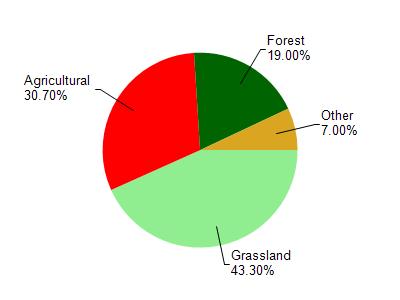Grant
Yes
No
No
Fish and Aquatic Life
Overview
Culver Branch is a spring fed tributary to the Platte River just south of the community of Ellenboro. It is considered a class II trout stream (WDNR, 1980). Its biological and recreational uses have been impaired over the years by agricultural nonpoint sources of pollution resulting in its listing on the 303(d) list of impaired waters. A species listed on the state’s threatened and endangered species list has historically been found along Culver Branch (WDNR, 1997). This endangered species is very sensitive to water pollution. Nonpoint source best management practices, particularly stream buffer corridors and managed grazing, would help protect and improve the stream.
Date 2001
Author Aquatic Biologist
Historical Description
Entire stream.
Date 1980
Author Surface Water Inventory Of Wisconsin
Historical Description
From: Smith, Tom D., and Ball, Joseph R., Lake and Stream Classification Project. Surface Water Resources of Grant County, Department of Natural Resources, 1972. Surface Area = 2.09 acres, Length = 2.3 miles, Gradient = 43 ft./mile, Flow = 2.5 c.f.s.
A rocky, spring-fed tributary of the Platte River located two miles south of Ellenboro. Firm pasture is the predominant bank type and some fairly deep pool areas are found throughout the stream. Brown trout have been stocked by the Platteville SportsmanB Club, but the stream is only considered as very marginal trout water. Forage fish including white suckers, bluntnose minnows, and creek chubs are commonly observed. Game assets including deer, raccoon, squirrels, and ruffed grouse are present in the watershed. One bridge crossing and the Platte River provide access. Only one dwelling is seen along the banks.
Date 1972
Author Surface Water Inventory Of Wisconsin
Condition
Wisconsin has over 84,000 miles of streams, 15,000 lakes and milllions of acres of wetlands. Assessing the condition of this vast amount of water is challenging. The state's water monitoring program uses a media-based, cross-program approach to analyze water condition. An updated monitoring strategy (2015-2020) is now available. Compliance with Clean Water Act fishable, swimmable standards are located in the Executive Summary of Water Condition in 2018. See also the 'monitoring and projects' tab.
Reports
Recommendations
Monitor Watershed (Status,Sources,Impairments)
Document monitoring conducted to de-list from impaired waters list.
Management Goals
Wisconsin's Water Quality Standards provide qualitative and quantitative goals for waters that are protective of Fishable, Swimmable conditions [Learn more]. Waters that do not meet water quality standards are considered impaired and restoration actions are planned and carried out until the water is once again fishable and swimmable
Management goals can include creation or implementation of a Total Maximum Daily Load analysis, a Nine Key Element Plan, or other restoration work, education and outreach and more. If specific recommendations exist for this water, they will be displayed below online.
Monitoring
Monitoring the condition of a river, stream, or lake includes gathering physical, chemical, biological, and habitat data. Comprehensive studies often gather all these parameters in great detail, while lighter assessment events will involve sampling physical, chemical and biological data such as macroinvertebrates. Aquatic macroinvertebrates and fish communities integrate watershed or catchment condition, providing great insight into overall ecosystem health. Chemical and habitat parameters tell researchers more about human induced problems including contaminated runoff, point source dischargers, or habitat issues that foster or limit the potential of aquatic communities to thrive in a given area. Wisconsin's Water Monitoring Strategy was recenty updated.
Grants and Management Projects
| Project Name (Click for Details) | Year Started |
|---|
|
|
Monitoring Projects
| WBIC | Official Waterbody Name | Station ID | Station Name | Earliest Fieldwork Date | Latest Fieldwork Date | View Station | View Data |
|---|
|
|

Watershed Characteristics
Culver Br is located in the Platte River watershed which is 197.74 mi². Land use in the watershed is primarily grassland (43.30%), agricultural (30.70%) and a mix of forest (19%) and other uses (7.00%). This watershed has 455.07 stream miles, 21.45 lake acres and 1,303.48 wetland acres.
Nonpoint Source Characteristics
This watershed is ranked Medium for runoff impacts on streams, Not Available for runoff impacts on lakes and High for runoff impacts on groundwater and therefore has an overall rank of High. This value can be used in ranking the watershed or individual waterbodies for grant funding under state and county programs.This water is ranked High Stream for individual Rivers based on runoff problems and the likelihood of success from project implementation.